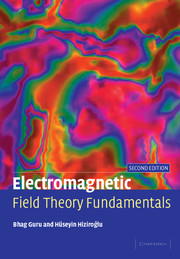Book contents
- Frontmatter
- Contents
- Preface
- Acknowledgments
- 1 Electromagnetic field theory
- 2 Vector analysis
- 3 Electrostatics
- 4 Steady electric currents
- 5 Magnetostatics
- 6 Applications of static fields
- 7 Time-varying electromagnetic fields
- 8 Plane wave propagation
- 9 Transmission lines
- 10 Waveguides and cavity resonators
- 11 Antennas
- 12 Computer-aided analysis of electromagnetic fields
- Appendix A Smith chart and its applications
- Appendix B Computer programs for various problems
- Appendix C Useful mathematical tables
- Index
5 - Magnetostatics
Published online by Cambridge University Press: 05 June 2012
- Frontmatter
- Contents
- Preface
- Acknowledgments
- 1 Electromagnetic field theory
- 2 Vector analysis
- 3 Electrostatics
- 4 Steady electric currents
- 5 Magnetostatics
- 6 Applications of static fields
- 7 Time-varying electromagnetic fields
- 8 Plane wave propagation
- 9 Transmission lines
- 10 Waveguides and cavity resonators
- 11 Antennas
- 12 Computer-aided analysis of electromagnetic fields
- Appendix A Smith chart and its applications
- Appendix B Computer programs for various problems
- Appendix C Useful mathematical tables
- Index
Summary
Introduction
The discovery of a permanently magnetized iron ore, lodestone, generated interest among scientists in an area of study called magnetism. Lodestone's ability to orient itself in the north and south directions led to the postulation of the existence of another force, which is now referred to as the magnetic force. A material that can be influenced (magnetized) by the magnetic force is called a magnetic material. Included in the family of magnetic materials are iron, cobalt, and nickel. A magnetized material is called a magnet. The end of a freely suspended magnet that points toward north is named as the north (seeking) pole; the other end is the south (seeking) pole. That a north pole of a magnet always points toward north had a profound influence on early navigation and exploration.
A magnetic field is associated with each magnet in the same way as an electric field is associated with a charge. Magnetic lines of force (outside the magnet) are said to emanate from the north pole and terminate at the south pole, as indicated in Figure 5.1. If another magnet is placed in the magnetic field, it will experience a force of attraction or repulsion. From experimental observations, it was found that like poles repel and unlike poles attract.
- Type
- Chapter
- Information
- Electromagnetic Field Theory Fundamentals , pp. 177 - 240Publisher: Cambridge University PressPrint publication year: 2004
- 2
- Cited by



